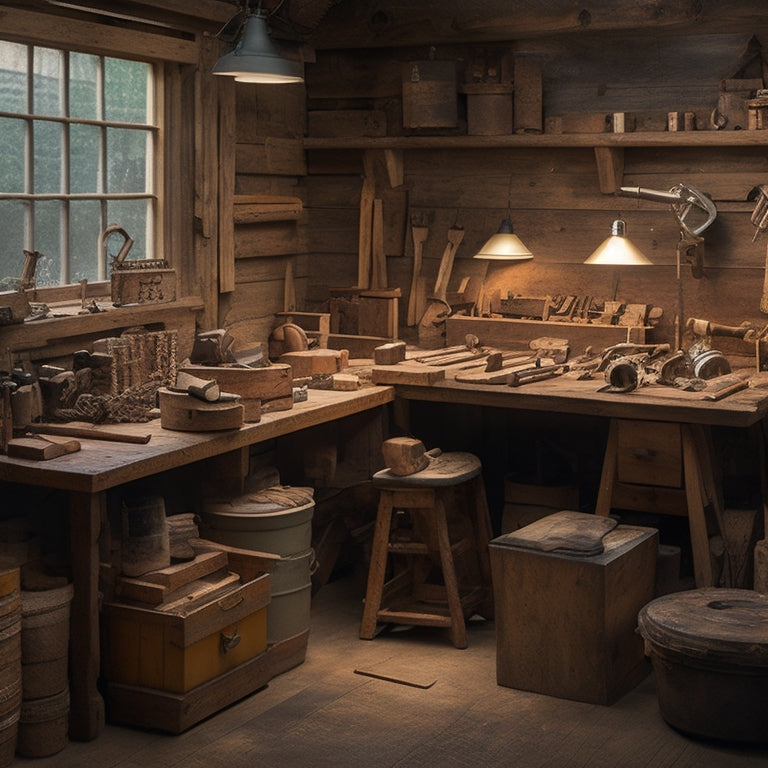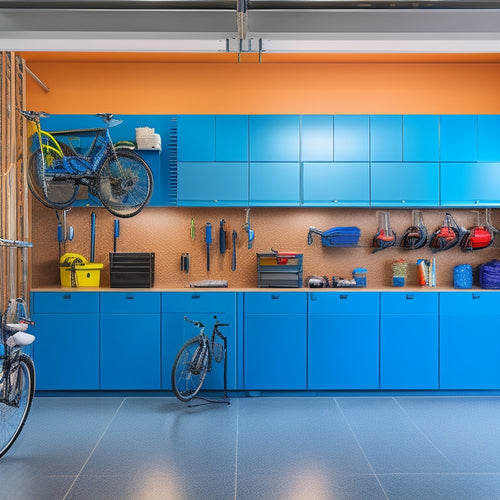
What Holds You Back From Woodworking Efficiency?
Share
You're losing precious time and sacrificing the quality of your woodworking projects due to inefficiencies that are easily identifiable and resolvable. Cluttered workshops, inadequate tool storage, and poor time management skills hold you back from completing projects efficiently. Lack of standardized processes, inadequate planning, and distractions further hinder your progress. Additionally, insufficient training, outdated equipment, and ineffective tool maintenance waste valuable time and resources. It's time to identify and tackle these obstacles head-on. By doing so, you'll uncover the root causes of your inefficiencies and discover the path to optimized woodworking productivity.
Key Takeaways
• Disorganized tool collections and cluttered workspaces hinder productivity and efficiency in woodworking projects.
• Inadequate time management and task prioritization lead to procrastination, distractions, and sacrificing quality.
• Lack of standardized processes and workflow optimization results in wasted time and resources.
• Inadequate project planning and execution lead to mistakes, confusion, and lack of focus.
• Insufficient skill development, tool maintenance, and equipment safety precautions hold back woodworking efficiency.
Inefficient Tool Organization Systems
Having a cluttered workspace and disorganized tool collection can hinder your productivity and turn what should be a fun and rewarding experience into a frustrating one. You know how it feels when you can't find the right tool or waste time searching for it. It's crucial to prioritize tool maintenance and organization to maximize your efficiency.
Start by categorizing your tools and assigning a designated spot for each one. This will help you develop a routine of putting tools back in their place after use, making it easier to find what you need when you need it.
Proper workspace ergonomics also play a significant role in your productivity. It's vital that your workspace is well-lit, comfortable, and free from distractions. This will help you stay focused and avoid fatigue.
Cluttered Workshop Environments
A cluttered workshop environment can suffocate your creativity, stifle your productivity, and even pose safety risks, making it essential to tackle this issue head-on.
You know the feeling - you're trying to focus on your project, but you're surrounded by chaos. Tools are scattered everywhere, and you can't find what you need when you need it. It's frustrating and inefficient.
To take control of your workshop, start by implementing clutter control measures. Designate a specific place for each tool and material, and make sure everything has a home. This will help you maintain a sense of organization and make it easier to find what you need.
Consider reorganizing your workshop layout to maximize workspace efficiency. Think about the flow of your work and how you can optimize your space to reduce waste and increase productivity.
Poor Time Management Skills
You've likely found yourself stuck in a time-wasting cycle, constantly playing catch-up and feeling overwhelmed by looming deadlines. This is often due to poor time management skills, which can be a major obstacle to woodworking efficiency.
One of the main culprits is procrastination habits. You put off tasks until the last minute, and then rush to complete them, sacrificing quality and accuracy. This not only wastes time but also leads to mistakes and rework.
Another significant time waster is a lack of prioritization. You allow distractions to derail your workflow, getting bogged down in non-essential tasks or getting sidetracked by social media or email notifications.
To break free from this cycle, you need to identify your procrastination habits and develop strategies to overcome them. This might mean breaking tasks into smaller, manageable chunks, setting realistic deadlines, and creating a schedule to stay on track.
Lack of Standardized Processes
You may think you're saving time by 'winging it' on each project, but without standardized processes, you're actually creating more work for yourself in the long run.
Inconsistent workflows persist because you're not taking the time to document and refine your methods.
Inconsistent Workflows Persist
In many woodworking shops, inconsistent workflows persist due to the lack of standardized processes, resulting in wasted time and resources. You might find yourself constantly adapting to changing project requirements, or repeating tasks because you didn't document the previous process. This inefficiency can be frustrating and costly.
When you don't have standardized processes in place, task prioritization becomes a challenge. You might struggle to determine which tasks to focus on first, leading to delays and bottlenecks in your workflow. Workflow optimization is also hindered, as you're forced to reinvent the wheel with each new project.
To overcome this, you need to establish clear, repeatable processes for each task. This will enable you to identify areas for improvement and streamline your workflow. By standardizing your processes, you'll be able to prioritize tasks more effectively, optimize your workflow, and make the most of your time and resources.
Processes Not Written Down
Processes remain stuck in your memory or scattered across scraps of paper, lacking a centralized documentation system that would allow for easy reference and improvement. This lack of standardized processes hinders your woodworking efficiency. When processes are not written down, you're prone to lost notes, forgotten steps, and missing instructions, leading to confusion and wasted time.
| Chaos | Control |
|---|---|
| Scraps of paper with incomplete notes | Centralized documentation system |
| Forgotten steps in a project | Step-by-step guides for future reference |
| Confusion among team members | Clear instructions for consistent results |
| Inefficient workflows persist | Improved workflows through process refinement |
Inadequate Storage Solutions
When you're dealing with inadequate storage solutions in your woodworking shop, you know how frustrating it can be. You're constantly searching for tools and materials, wasting precious time that could be spent on actual projects.
Your disorganized tool layout and insufficient shelving space are likely the main culprits, and it's time to tackle these issues head-on.
Disorganized Tool Layout
You're likely wasting valuable time searching for misplaced tools, a direct consequence of your disorganized tool arrangement and inadequate storage solutions. This not just hinders your workflow but also raises the chances of tool damage and safety risks.
A messy workspace can result in tool maintenance problems like rust and corrosion, which can be expensive to fix or even necessitate replacement. Additionally, disorganization can jeopardize tool safety, raising the chances of accidents and injuries.
To tackle this challenge, implementing a well-planned tool arrangement strategy is crucial. Begin by categorizing your tools based on how often they're used, their type, and size. Then, allocate a specific place for each tool, ensuring they're easily accessible and visible.
Consider investing in tool chests, cabinets, or pegboards to keep your tools orderly and close at hand. By taking these steps, you'll not only save time but also decrease the risk of tool damage and safety mishaps, enabling you to concentrate on the most important aspect – creating top-notch woodworking projects.
Insufficient Shelving Space
Inadequate shelving space hampers your woodworking efficiency, forcing you to clutter your work surface with materials and supplies, which in turn slows down your project's progress. This disorganization not only wastes valuable time but also leads to frustration and decreased productivity.
To overcome this hurdle, consider investing in creative shelving solutions that maximize your workshop space. By doing so, you'll be able to store your materials and supplies in an organized and accessible manner, freeing up your work surface for actual woodworking.
Custom shelving designs can be tailored to fit your specific needs, ensuring that every inch of your workshop is utilized efficiently. By optimizing your storage space, you'll be able to quickly locate the tools and materials you need, streamlining your workflow and increasing your productivity.
With a well-organized workshop, you'll be able to focus on what matters most - creating high-quality woodworking projects that showcase your skills and creativity. By addressing your insufficient shelving space, you'll be able to take your woodworking efficiency to the next level.
Incomplete Project Planning
Unclear objectives and unrealistic timelines often sabotage your woodworking projects from the outset, leading to wasted time and resources. You're excited to start building, but without a clear plan, you'll likely encounter setbacks and frustrations. Incomplete project planning can lead to confusion, mistakes, and a lack of focus.
To avoid these pitfalls, take the time to brainstorm your project thoroughly. Consider the purpose, design, and functionality of your project. Make a list of the materials you'll need and make sure you have them readily available. This initial planning stage will save you time and effort in the long run.
Next, create a detailed sketch of your project, including measurements and specifications. This will help you visualize the final product and identify potential issues.
Prioritize your tasks, breaking down the project into manageable chunks. This will enable you to stay focused and on track, ensuring your project is completed efficiently and effectively.
Distractions and Interruptions
Even with a solid plan in place, woodworking projects can still be derailed by distractions and interruptions that chip away at your focus and productivity. External distractions, such as phone notifications, visitors, or background noise, can be significant obstacles to your woodworking efficiency. Internal interruptions, like daydreaming, fatigue, or mental blocks, can also hinder your progress.
To overcome these hurdles, developing effective time management skills and strategies for focus retention is crucial. Set specific work sessions with regular breaks to maintain your energy and concentration. Create a conducive work environment by minimizing external distractions and using tools like noise-cancelling headphones or website blockers.
When internal interruptions arise, take a step back, reassess your task, and break it down into smaller, manageable chunks. By recognizing and addressing these distractions and interruptions, you can regain control of your woodworking project and stay on track to achieve your goals.
Unnecessary Task Repetition
When you find yourself redoing tasks or repeating steps, it's likely that unnecessary task repetition is consuming your woodworking efficiency. This can be frustrating and demotivating, but identifying the root causes can help you overcome it. One common culprit is poor task prioritization. When you don't have a clear plan, you may end up jumping between tasks, leading to repetition.
Take the time to prioritize your tasks, focusing on the most vital ones first.
Another contributor to unnecessary task repetition is inadequate tool maintenance. Dull or malfunctioning tools can lead to subpar results, forcing you to redo tasks. Regularly maintain your tools to make sure they're in top condition.
Workflow optimization is also essential. Analyze your workflow and identify areas where you can streamline processes, reducing the need for repetition. Consider project batching, where you group similar tasks together, completing them in one session.
Insufficient Training and Skills
Lack of proficiency in essential woodworking skills or inadequate training can hinder your efficiency, leading to mistakes, rework, and wasted time. When you're not confident in your abilities, you'll likely spend more time on a project than necessary, and the quality of your work may suffer. To overcome this hurdle, focus on skill development through training programs, online tutorials, or classes. These resources can teach you new techniques, improve your understanding of woodworking principles, and enhance your overall expertise.
In addition to formal training, practical experience is vital for hands-on learning. The more you work on projects, the more comfortable you'll become with various tools and techniques. You'll develop muscle memory, and your workflow will become more efficient. Don't be afraid to start with small projects and gradually move on to more complex ones.
As you gain experience, you'll identify areas that need improvement and can target your training efforts accordingly. By investing time and effort in developing your skills, you'll become a more efficient woodworker, capable of producing high-quality work in less time.
Outdated Equipment and Tools
Using old or outdated equipment and tools can significantly slow you down, as you'll likely spend more time struggling with your machinery than actually woodworking. This not only hampers your productivity but also increases the risk of accidents. Outdated tools can be hazardous, and using them can lead to injuries or damage to your projects. Furthermore, they often require more effort and time to produce subpar results, which can be frustrating and demotivating.
Regular tool maintenance is essential to make sure your equipment is in good working condition. It's crucial to inspect your tools regularly, clean them, and perform any necessary repairs or replacements. This will help prevent breakdowns and prolong the life of your equipment.
Additionally, it's essential to take safety precautions when working with power tools. Always wear protective gear, such as safety glasses and gloves, and make sure your workshop is well-ventilated and well-lit. By keeping your tools up-to-date and well-maintained, you'll be able to work more efficiently and safely, allowing you to focus on creating high-quality woodworking projects.
Frequently Asked Questions
How Do I Maintain Focus During Long Woodworking Projects?
As you start on a woodworking marathon, don't let mental fatigue hijack your journey. You'll stay on track by mastering time management, dodging distractions, and taking strategic breaks to refuel and recharge, ensuring your focus remains sharp as a chisel's edge.
Can I Repurpose Old Tools to Save Money and Space?
You can repurpose old tools to save money and space by restoring them to their former glory or upgrading with budget-friendly modifications, giving new life to forgotten gems and freeing up valuable workshop real estate.
Do I Need a Dedicated Workshop for Efficient Woodworking?
You don't necessarily need a dedicated workshop for efficient woodworking; consider a garage setup with portable solutions, like modular workbenches and tool chests, to optimize your space and workflow.
How Often Should I Clean and Maintain My Tools?
'Savvy woodworkers stay sharp by scheduling regular tool tune-ups, tackling tidying tasks daily, and tackling rust risks with lubrication, ensuring your equipment stays in excellent condition and your projects progress promptly.'
Can I Involve Friends or Family in My Woodworking Projects?
You can definitely involve friends or family in your woodworking projects, turning them into fun group collaborations that foster teaching opportunities and bonding.
Related Posts
-

Top Garage Storage Bins for Organization and Style
You can enhance your garage's style and organization with the right storage bins. Top brands like Rubbermaid, Suncast...
-

Bin Garage Storage Ideas for Maximizing Space
You can greatly maximize your garage's storage space by utilizing vertical space with ceiling storage bins, stacking ...
-

Benefits of Pegboard Racks in Your Garage
By installing a pegboard rack in your garage, you'll reveal a wealth of benefits that change your workspace into a hi...


